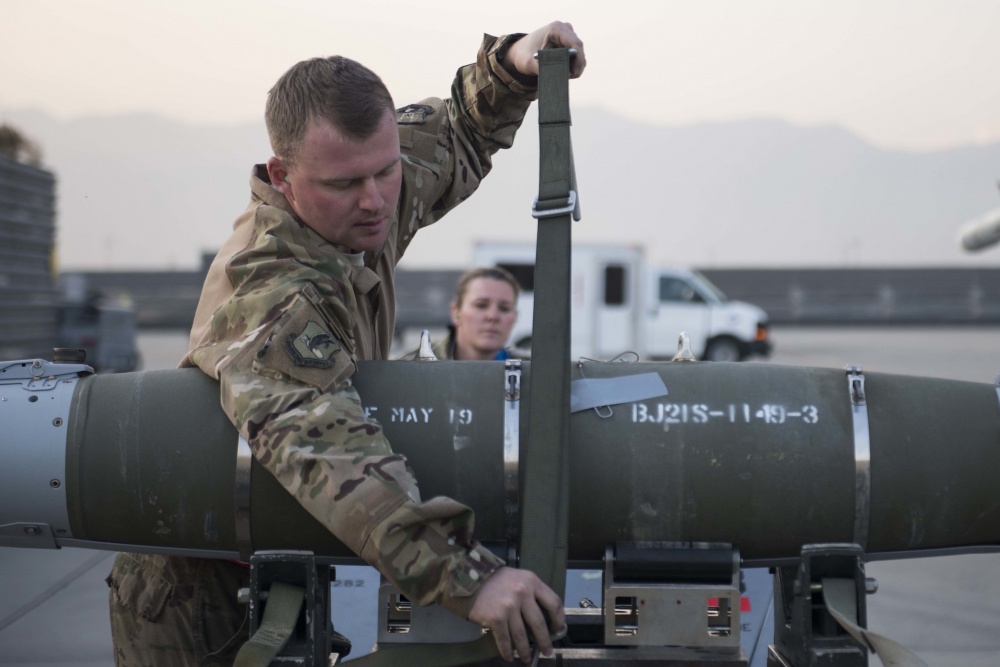
SSgt. Austin Dall, 455th Expeditionary Aircraft Maintenance Squadron F-16 weapons load crew team chief, secures a bomb on a jammer operated by Airman 1st Class Kara Hayek, 455th EAMXS weapons load crew member, during a weapons load at Bagram Airfield, Afghanistan, Dec. 8, 2018. President Trump vowed in his State of the Union address to bring troops home from Afghanistan and Syria. Air Force photo by SrA. Kaylee Dubois.
President Donald Trump on Tuesday night vowed to bring American troops home from the Middle East, while pledging to build up the US military presence along the southern border.
The US has been fighting in Iraq and Afghanistan for nearly two decades. More than 7,000 Americans have died and more than 52,000 have been wounded, Trump said during his second State of the Union address, noting also the US has spent “more than $7 trillion” in the wars.
“As a candidate for President, I pledged a new approach. Great nations do not fight endless wars,” he said.
In Afghanistan, the US is holding “constructive talks” with the Taliban and other Afghan groups, paving the way for a reduced US presence there.
“We do not know whether we will achieve an agreement, but we do know that after two decades of war, the hour has come to at least try for peace, and the other side would like to do the same thing. It’s time,” Trump said.
Earlier in the day, US Central Command boss Army Gen. Joseph Votel told members of the Senate Armed Services Committee the US mission in Afghanistan “has not changed.” Votel reiterated that the South Asia Strategy is working and acknowledged the conflict cannot “be resolved solely by military force.” However, he also emphasized that US “military pressure serves as an enabler for a whole-of-government process and more directly supports diplomatic efforts.”
In Syria, Trump said, “It is time to give our brave warriors … a warm welcome home,” noting that “virtually all” of the territory once claimed by ISIS has been liberated and the US is diligently working with allies to “destroy the remnants.”
In the Senate hearing, Votel said there are now just 1,000 to 1,500 ISIS fighters dispersed over less than 20 square miles of territory, compared to the 34,000 square miles once controlled by ISIS in Iraq and Syria. He acknowledged he was not consulted before Trump announced plans to withdraw troops from Syria, but said his command is working on options for how to keep pressure on ISIS after the US leaves. As of now, a no-fly zone over Syria is not on the table, he added.
Trump’s comments come one day after the Republican-controlled Senate broke with the President, voting 70-26 in favor of an amendment sponsored by Senate Majority Leader Mitch McConnell warning against a “precipitous withdrawal” of US forces from Syria and Afghanistan. The measure was added to a wide-ranging foreign policy bill still pending on the Senate floor, reported the Associated Press.
Meanwhile, in the US, Trump said he “has ordered another 3,750 troops to our southern border to prepare for the tremendous onslaught” from “large, organized caravans on the march to the United States.”
As of late January there were approximately 2,350 Active Duty troops deployed to the border, down from nearly 6,000 in November 2018. Under Secretary of Defense for Policy John Rood told House legislators recently he expected US military deployments to the border to continue through fiscal 2019.
In a statement released late Tuesday, acting Defense Secretary Patrick Shanahan said Trump’s State of the Union address “reaffirmed his unwavering commitment to support our troops and to protect American national security interests at home and abroad.”